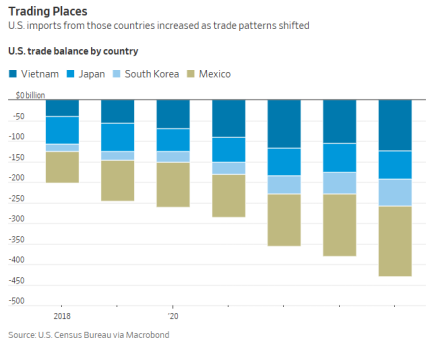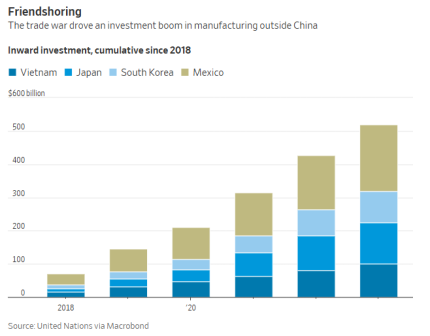President Trump announced what he calls reciprocal tariffs yesterday, but reciprocal means the same doesn't it?
Simple Definitions:
- reciprocal: done, given, or felt equally by both sides.
- reciprocal affection: related to each other in such a way that one completes the other or is the equal of the other.
Full List of Countries Hit With Reciprocal Tariffs:
You will note that the tariffs announced were at a 10% floor to meet most countries at Reciprocal as defined. The countries that are tariffing us higher than 10% we addressed with a 50% US tariff. That is hardly reciprocal as defined. Below are comments from Strategas Research:
President Trump announced his tariff proposal today, which is near the worst-case scenario. We estimate the proposal will generate roughly $500bn of tariff revenue on top of the $150bn that has already been enacted. Trump said he wanted $500bn and he got it. This represents 2.2 percent of GDP and twice the size of the largest tax increase in modern US history.
- Proposal Is A 10% Universal Tariff + Plus Higher Rates for Countries With Higher Tariff Rates And/or Large Trade Deficits: The main basis of the plan is a 10 percent universal tariff rate. For countries with larger trade deficits and/or high tariff rates, the US will impose even higher rates above the 10 percent.
- All EU Imports Will Face a Higher Rate + 58 Other Countries: The rates will exceed 10 percent for 58 countries and every import from the EU will face a 20 percent rate. Some of the rates are so high, the proposal is hard to believe. My back of-the-envelope calculation suggests that Vietnam will face tariffs of more than 10 percent of GDP.
- Trump Is Near His Campaign Proposal Of 60% China Tariff Rates: Under the new proposal China will be hit with an additional 34 percent tariff rate. This is on top of the 20 percent already enacted, raising the total to 54 percent. As a candidate Trump promised to raise China tariffs to 60 percent. Trump also eliminated the de minimis exemption.
- Mexico & Canada Are the Relative Winners Under The New Plan: Mexico and Canada will not be subject to the 10 percent tariff. The existing 25 percent tariff on non-USMCA compliant goods will remain in place.
- The Rates Came in Higher Than The Consensus Estimated: US Allies are facing high tariff rates such as Japan (24%), South Korea (25%), Vietnam (46%), and Taiwan (32%).
- Use of IEEPA Will Likely Face a Legal Test: These tariffs were enacted under the International Emergency Economic Powers Act (IEEPA) and will likely face a legal test about whether IEEPA can be used for such sweeping tariffs by executive action.
- The Foreign Policy Implications Are Enormous: These are not small tariffs and are so large that the economic implications may not be the only impact. There will likely be foreign policy implications and non-US countries are likely to shun US products and companies moving forward.
- Congress Now Has the Revenue to Lower Corporate and Individual Income Tax Rates: The Trump proposal today is roughly a doubling of the corporate tax rate. With this new revenue source, Congress will need to deliver on a large tax cut to sterilize the negative impact of higher tariff rates. This must be bigger than just 100 percent expensing of capital goods; it needs to be large-scale tax rate reductions.
- A Sharp Negative Market Reaction Should Catalyze Congress to Move Closer to Getting A Tax Bill Completed: The House and Senate remain at odds over the level of spending cuts. Our sense is that some of these issues will be worked out in the coming weeks to get the tax bill into effect quickly given the negative impact of the tariffs.
- We Expect the US Budget Deficit to Come Down Sharply in the Short Run: March looks to be an $80bn deficit reduction month and we see it as the first sign of the deficit coming down from April tax revenues. The tariffs will only add to that and the deficit will come down faster than the consensus expects. As such, there will be a downward adjustment of Treasury issuance, even if a portion of the revenue is used for tax cuts.
Source: Strategas
There was a very interesting article this morning on the Wall Street Journal:
Trump Tariffs Aim to Bring Down Curtain on Era of Globalization
The president wants companies to return production to the U.S., but it won’t be easy
Here are some of the more interesting comments in the article that explains why the Trump administration is pursuing this policy currently:
“Jobs and factories will come roaring back into our country, and you see it happening already,” Trump said in a Rose Garden ceremony Wednesday. To any company or country that complains, he said: “If you want your tariff rate to be zero, then you build your product right here in America.”
Trump’s Made-in-America ambitions mean that a gusher of investment that in recent years showered low-cost manufacturing destinations such as Vietnam, as well as U.S. allies such as South Korea and Japan, is set to dry up. Firms are reconsidering their options for where best to spend their investment dollars.
In the weeks since Trump took office, a flurry of new announcements by companies including iPhone maker Apple, South Korean carmaker Hyundai and drugmakers Johnson & Johnson and Eli Lilly signal that multinationals are gearing up to expand operations in the U.S. in response to Trump’s tariffs.
The president’s hope is that high tariff walls will usher in a golden age of plentiful manufacturing jobs and widespread prosperity as industrial production blossoms across the U.S. He blames predatory trade practices by China, the European Union and other American trade partners for sucking jobs and industries overseas, which he now wants to bring back.
The U.S.’s two largest trading partners, Mexico and Canada, were spared new tariffs Wednesday, with any goods compliant with their free-trade agreement still subject to no duties. But both countries still face 25% duties that Trump imposed on a large share of their exports not covered by the agreement, as well as the continuing threat that the president could blow up the deal over non-trade issues such as drugs and migration.
On Wednesday, Trump singled out China. It was the biggest beneficiary of the offshoring trend, over decades building out factories that started with toys and clothes and today make high-tech cars, machinery, and electronics. Today, it dominates global manufacturing, with a trade surplus last year of $1 trillion.
A new 34% tariff on China announced Wednesday will be additive to previous duties imposed by the Trump administration, like the 20% tariff that Trump imposed over its role in the fentanyl trade.
Driven by growing geopolitical tensions between Washington and Beijing and the trauma of the pandemic, multinationals have added new production bases outside of China to keep their operations running smoothly in the event of disruption from shipping delays, natural disasters, economic sanctions, or conflict. Apple, for instance, began making some iPhones in India.
At the same time, Chinese companies have built out their own overseas production facilities, in part to escape brutal competition in their cutthroat domestic market but also to keep serving multinational clients and to sidestep U.S. tariffs on Chinese imports. Mexico and Vietnam have been popular destinations, thanks to low costs and, in Mexico’s case, tariff-free access to the U.S. market.
For the U.S., the result has been a fall in the share of its imports coming from China but widening deficits with Vietnam, Mexico, and other countries. The overall U.S. current-account deficit, a broad measure of trade and income from overseas, in 2024 reached $1.1 trillion, underscoring to Trump and his allies the need to revamp global trade.
With his return to the White House, Trump has taken his trade war to adversaries and allies alike, whom he accuses of taking advantage of the global trading system the U.S. nurtured after World War II by pushing exports and restricting imports. Some analysts say such policies do indeed drive U.S. trade deficits, though most mainstream economists cite the U.S.’s persistent budget deficits and low savings rate as the principal drivers of the yawning trade gap.
There are signs Trump’s strategy is having an effect. Around half of German engineering businesses want to boost U.S. investment, both because of the tariffs and the size of the market, according to a November survey by the German Mechanical Engineering Industry Association, or VDMA, a lobby group. Most members “look to the U.S. as a growth opportunity,” said Andrew Adair, a VDMA official.
German engineering giant Siemens said last month it would increase by $10 billion its investments in the U.S., its largest market. That includes new manufacturing facilities for electrical products in Fort Worth, Texas, and Pomona, Calif., creating over 900 skilled manufacturing jobs, the company said.
Taiwan Semiconductor Manufacturing said last month that it plans to invest at least $100 billion more in chip-manufacturing plants in the U.S. over the next several years. On Wednesday, Trump said Taiwan would face 32% tariffs, though semiconductors would be exempted.
“We must be able to build the chips and semiconductors that we need right here in American factories with American skill and American labor, and that’s exactly what we’re doing,” Trump said when announcing the deal alongside TSMC Chief Executive C.C. Wei in the White House.
Taiwanese electronics companies Foxconn, Compal and Inventec have said they are seeking new investments in Texas, looking to secure land for AI-server manufacturing that could eventually rival the scale of their existing operations in Mexico.
Mexico became a hub for manufacturing the servers needed by large U.S. tech companies to power artificial intelligence, with around 70% of the U.S. server imports arriving from the country and another 20% coming from Taiwan, according to a report by Taiwan’s Ministry of Economic Affairs.
As stated above by Strategas: We Expect the US Budget Deficit to Come Down Sharply In The Short Run:
The markets do not like uncertainty and the new trade policies certainly create uncertainty. But as mentioned in the Wall Street Journal article, onshoring and major investment in US manufacturing has already started. While negotiations are taking place and onshoring is happening we will be reducing our deficits and long term we will be stimulating growth in the US.
All in all, not a bad place to be while we are waiting for manufacturing to return to the US to stimulate economic growth, Job growth, shore up national security, and lower taxes and regulations. We think we need to wait for this to play out and that markets will be volatile for the next several months while negotiations are taking place.
It has been our opinion that the markets have been overvalued and led up by just a few companies tied to AI (the Mag 7 stocks). They have been the stocks that have been the most overvalued and have led the market down this year, just like they led the markets up in the last two years. Longer term those companies will lead the markets higher but as for now they are very expensive and there are better values available for investors to explore.
We have built our portfolios to expect this uncertainty and have invested heavily in Value Companies. Companies that are paying nice dividends to offset market volatility and trading at valuations below what the S&P market has been trading over the last few years. Our portfolios are built to outperform in volatile markets like we are seeing, and we will be doing minor rebalancing in the next few weeks to further take advantage of the current market volatility.
Source: Wall Street Journal, by Jason Douglas and Tom Fairless
Please feel free to call or email us with any questions or concerns you may have.
Sincerely,
Fortem Financial
(760) 206-8500
team@fortemfin.com









